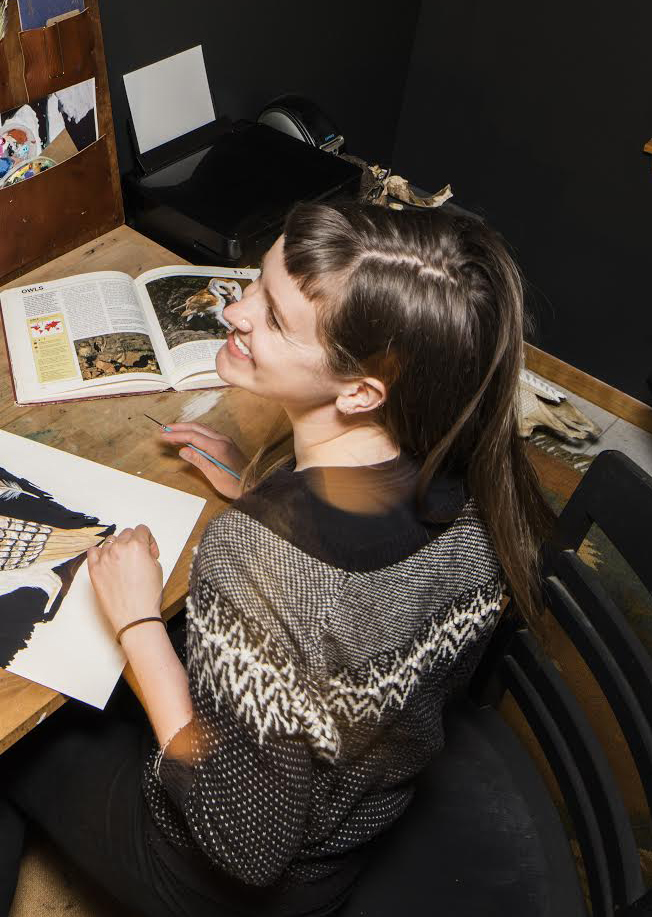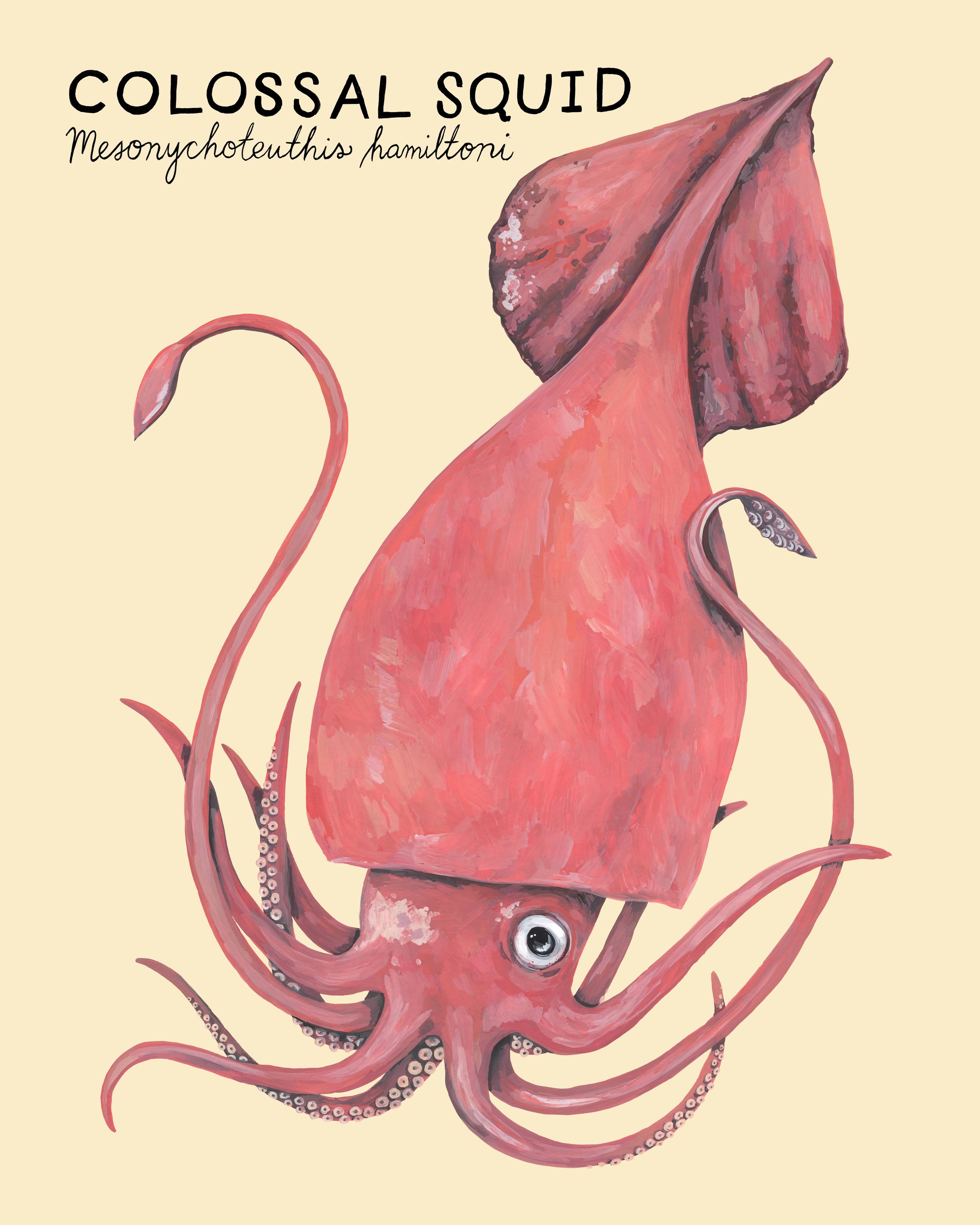Artist Interview with Kelsey Oseid
Meet Kelsey, a Minneapolis-based illustrator, author, and naturalist. She often creates posters of different animals in series such as Kelzuki’s Animal Kingdom and Ocean Giants. She also wrote and illustrated What We See in the Stars: An Illustrated Tour of the Night Sky releasing this fall and available for preorder now!
Kelsey’s work is characterized naturalistic gouache paintings of any and all kinds of animals. Much of her work is reminiscent of field guide illustration, and is charming, detailed, and informational. She has a lot of love for the natural world, and it shows in her art. We’re excited to exhibit her work as a local artist in the Page Gallery. For more of her work, visit her website, or her other links below the interview!
Enjoy!
Can you tell me more about yourself, your creative background, hometown, schooling, accomplishments, etc.
Yes! I was born in Minneapolis and have lived here most of my life, excepting my time in Chicago for college--I have a degree in Visual Communications and a degree in Sociology from Loyola University Chicago. My dad taught me how to paint when I was really young, and we would paint together- we took a few classes together at the Minnesota School of Botanical Art when I was a teenager and that kind of sent me on a path of really loving nature art. I've illustrated a few educational children's books, including a fun and silly one called "Whose Poop is That" for young readers, about different animals and their scat. My first author/illustrated book is coming out this September from Ten Speed Press. It's called "What We See in the Stars" and it's an illustrated tour of the myths, histories, and science of the celestial bodies of our solar system, with stories and information about constellations, planets, comets, the northern lights, and more.
What does your studio/workspace look like? What’s your dream workspace?
I work in a spare bedroom in my house and I am lucky to have it all to myself! I have a workspace set up against one wall, which includes my desktop Mac, my scanner, and room for me to paint and draw as well. It's nice since I often am scanning, Photoshopping, and painting in turn throughout the day. And then the walls are covered in inspiration images- wildlife photos torn from magazines, nature art by other illustrators, deer skulls, feathers, dried flowers, and some treasured drawings I have that my dad did as a teenager. I am in my dream workspace. I LOVE being able to surround myself with the things I find beautiful.
What do you love most about your own work? What sorts of themes, ideas, philosophies do you incorporate into your practice?
My work has narrowed in content over the past few years, and I'm currently spending most of my time illustrating natural history subjects- primarily animals. I am a massive natural history nerd, so what I love MOST about my work is that it justifies my spending obsessive amounts of time learning about natural history! I'm not a scientist, but I think of myself as a science enthusiast- my worldview is really centered around science and the more I can celebrate and promote that, the better! I have personally coined the embarrassing word "celebra-cational"- this is my first time admitting that publicly, ha!- which is what I kind of think of my work as being. It's halfway between a celebration of the natural world and education about it. I want everything I make to have an educational element, but I also always want it to feel beautiful and honoring and celebratory about the Earth's amazing bounty and complexity.
What is your creative process like? Is it made of simple linear steps or do you just wing it? What kind of research goes into your process?
It depends on how much time I have, and whether I'm working with a science consultant, but my ideal process is to really delve into all the source material I can find related to the species I'm illustrating. Even though my style is a little whimsical and stylized, I still like to be scientifically accurate within those boundaries, with regards to anatomy, proportion, etc. I always start with Google images, which I'm not ashamed to admit. How amazing is it that we have such a thorough library of encyclopedic resources at our fingertips?! Then I usually move on to reading up on the species via some of the nature guides I have at home, and websites like National Geographic, IUCN, and the World Wildlife Fund. If I can find video of the species in action, I watch that too. Mostly, I want to understand the key descriptors of the species so I can represent it well. But also, I just like to nerd out about zoology.
How do you stay inspired to create? Do you keep a journal or sketchbook?
I keep a running list of ideas in a journal, but I'm awful about sketching. It's something I'd like to get better at, but I never have the time or the patience- I just want to get right into the final product. As a nature illustrator, I'm constantly inspired. Checking in on nature news and facts- especially related to animals- is a daily touchstone for me. I love watching animal documentaries, and there are so many incredible people making them nowadays, it's like an endless pool of inspiration. When I'm in a slump and feeling uninspired, there are a few classic naturalists and conservationists whose work I look to, to reignite my passion. I'll just watch a bit of David Attenborough, or read some Jane Goodall or EO Wilson, and try and absorb some of their excitement and devotion to the natural world.
What do you love about the natural world? Where do you think this fascination comes from?
David Attenborough says that all children are fascinated by nature when they're young, but they often lose that fascination as they grow up. So I may just never have lost it. I will say there is often a definite "childlike" vibe to my work, just by the nature of the style and the subject matter. People sometimes describe my taxonomy illustrations as "nursery decor," and I know there are lots of young kids who connect with it (which is so awesome). There's something about nature that kind of captures that youthful sense of imagination and wonder. I guess I'm trying to reconnect with that in the work I make. By the way, I think my work can be for people of all ages! (But I did recently hear from a parent that their two kids were having a fight over who got to have their Lepidoptera poster- from my shop- in their room, so they had to take turns. That made me extremely happy!!!)
How do you gather resources and materials to create? What sorts of things do you learn from your practice?
My materials are pretty straight-forward. I usually use gouache- whatever brand I can get my hands on at this point, although Winsor & Newton is a favorite. Once in a while I'll use a matte acrylic paint for broad areas of color. And as far as paper goes, I'll basically use anything thick enough to take the paint. I like gouache as a main art material because it allows for really fine detail and lots of different textures (at least I think it does). It's cool how by painting a subject, you are forced to study it and make new discoveries about it, often in ways you just can't just by looking at it. By trying to replicate a subject, you learn more about it. I love that.
What are some hobbies you enjoy doing? How do your personal interests find their way into your art making?
Ooh! I like going on walks and visiting parks and gardens, which definitely can serve as inspiration. I also really like knitting, especially when it's a garment I'll be wearing myself. I like feeling connected to the objects around me, and knitting is an awesome way to do that. It helps you look at the world in a different way, to slow down and take the long way 'round- instead of just buying a sweater, spending hours upon hours building it up from spun yarn. There are definitely parallels between that and my illustration practice. I also love coffee and that finds its way into my art via me spilling it onto my work all the time >.< HA!
Your work balances aspects of natural history, science and art. How did you find this balance?
Thanks! That's so nice! I just really love illustrating, and I think there's something to be said for science-y art that isn't super rigidly scientific, if that makes sense.
Last year, you did a series illustrating different taxonomic orders of animals in Kelzuki’s Animal Kingdom. What did you learn about yourself and your work during you time making it?
This project was the first time I really dedicated myself to animal/taxonomy art and it just proved to me that I really do love it and can lean into it! People have asked me if I'm bored of painting animals, and all I can say is NO because I love it so much.
You started a new series called Ocean Giants Month for the month of May. What can you tell us about the project?
Yes! I liked doing a daily series in 2016- that was Kelzuki's Animal Kingdom- so I'm restarting the daily practice with a project called Kelzuki's Natural World (#kelzukisnaturalworld whatup). I'm choosing a different natural history topic for each month, and I'll be creating daily posts about that topic and sharing them on social media. For May, I started off with a month of ocean giants- some of the biggest, heaviest, longest marine creatures on Earth. I'm going to be showing the culmination of this project at Light Grey (: And stay tuned for my next themed month, which I'll announce at the end of May. It should be fun!
What can people expect to see from your work during your exhibition at Light Grey?
I'll be showing my final "Ocean Giants" compilation along with some other illustrations of species from all around the world, including the deep sea, where humans have yet to fully explore, and other spots around the world, from Africa to Asia to North America and more.
Where can people find/follow your work?
I'm online at www.kelzuki.com, and I also post daily on Instagram at @kelzuki.
Thanks so much, Kelsey!








